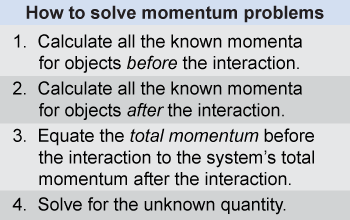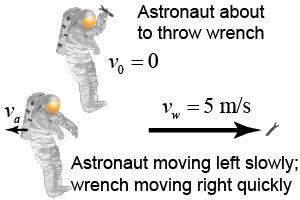|
The law of conservation of momentum is a powerful tool for understanding how objects move after they interact. A rocket expelling exhaust, a car crash on the highway, and the recoil of a hunter’s rifle all involve objects exchanging action–reaction forces. All can be understood by studying momentum. How can we put the law of momentum conservation to work? 
|

|
Imagine a system with two objects that can only move to the left or right. They may or may not collide; they may or may not stick together if they do so. It doesn’t matter: The total momentum of any closed system remains unchanged. This rule applies as long as any outside forces on the system add up to zero. 
|
 To solve momentum problems, set up a table showing the momentum of each object, both before and after the objects interact. (Subscripts are often used to identify the two objects or to indicate initial and final values.) If the motion is along a single axis, decide which direction corresponds to positive velocity. Then be sure to assign plus or minus signs accordingly.
To solve momentum problems, set up a table showing the momentum of each object, both before and after the objects interact. (Subscripts are often used to identify the two objects or to indicate initial and final values.) If the motion is along a single axis, decide which direction corresponds to positive velocity. Then be sure to assign plus or minus signs accordingly. 
|
Typically you can calculate most of the momenta right away and state a number in kilogram-meters per second. At least one momentum value, however, will contain an unknown variable: the quantity you are trying to solve for. You may need to rearrange the equation. 
|
 A motionless 100 kg astronaut is holding a 2 kg wrench while on a spacewalk. To get moving, the astronaut throws the wrench forward at a speed of 5 m/s. How fast does the astronaut move backward?
A motionless 100 kg astronaut is holding a 2 kg wrench while on a spacewalk. To get moving, the astronaut throws the wrench forward at a speed of 5 m/s. How fast does the astronaut move backward? | Asked: | astronaut’s final velocity va | | Given: | masses mw = 2 kg (wrench) and ma = 100 kg (astronaut); initial velocity v0 = 0 (both); final velocity vw = 5 m/s (wrench) | | Relationships: | momentum p = mv; momentum conservation | | Solution: | Momentum before equals momentum after: Solve for the astronaut’s final velocity: | | Answer: | The astronaut moves 0.1 m/s backward (negative direction). | 
|
Suppose that the astronaut (above) gave the 2 kg wrench a speed of 10 m/s rather than 5 m/s. What effect would this have on her own recoil speed? - It would not change her recoil speed.
- It would divide her speed by two (va = −0.05 m/s).
- It would multiply her speed by 2 (va = −0.2 m/s).
 |
The answer is c: it would multiply her speed by 2. Generally speaking, when two bodies are propelled away from each other, doubling one of the speeds will double the other. In this case, this can be seen by inserting the different value for the final wrench velocity, vw, and solving as before: Now we rearrange terms to solve for the unknown quantity, the astronaut’s velocity (va): The astronaut’s recoil speed has doubled. 
|
Suppose that the astronaut (above) had a mass of 50 kg rather than 100 kg (but all other given quantities remain unchanged). What effect would this have on her recoil speed? - It would not change her recoil speed.
- It would divide her speed by 2 (va = −0.05 m/s).
- It would multiply her speed by 2 (va = −0.2 m/s).
 |
The answer is c: it would multiply her speed by two. Generally speaking, when two bodies are propelled away from each other, reducing the mass of one object (while leaving everything else unchanged) will increase that object’s recoil velocity. In this case, this can be seen by inserting the different value for the astronaut mass, ma, and solving as before:
Now we rearrange terms to solve for the unknown quantity, the astronaut’s velocity (va):
The astronaut’s recoil speed has doubled. 
|

